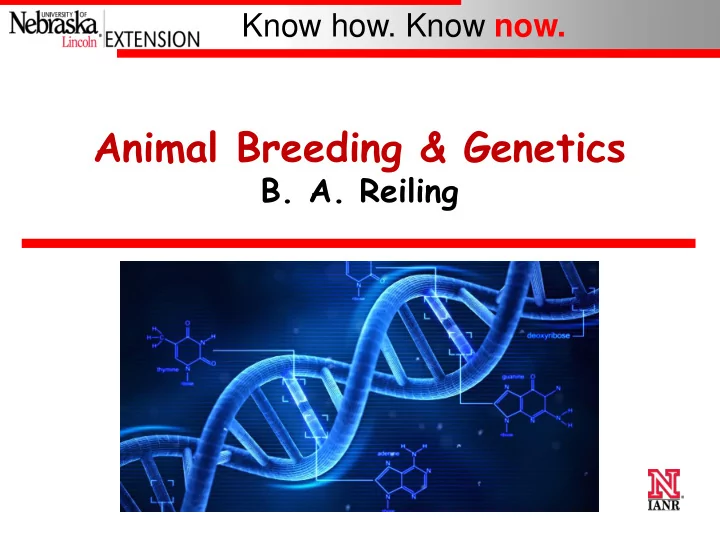

Know how. Know now. Animal Breeding & Genetics B. A. Reiling
Know how. Know now. Brief History of Genetics 1866 – Gregor Mendel & his “garden peas” Sought to understand • Why were the peas consistent within lines, • but different between lines? Helped define the rules of inheritance • Dominance vs. Recessiveness Late 1800’s, Johann Friedrich Miescher Isolated the “genetic blueprint” DNA 1953 – Watson & Crick Describe the chemical structure of DNA • Double-helix; tied together with nucleotides University of Nebraska – Lincoln
Know how. Know now. DNA, Chromosomes, & Genes 4 nucleotides (bases) for mammalian genome Adenine, Cytosine, Guanine, & Thymine Mammalian DNA varies in length & organization Dependent on species • The human genome: 3.3 billion base pairs • The swine genome: 2.8 billion base pairs • The cattle genome: 3.0 billion base pairs • The canine genome: 2.4 billion base pairs University of Nebraska – Lincoln
Know how. Know now. DNA, Chromosomes, & Genes Bases divided into thread-like structures Chromosomes Number & size of chromosomes differ by species Humans: 23 pairs of chromosomes • 22 pairs of autosomes & 1 pair of sex chromosomes Pigs – 19 pairs; Cattle – 30 pairs; Dogs – 39 pairs. Chromosomes organized into functional subunits Genes, that consist of specific base sequences • Base sequences “instructions” proteins phenotype Alleles – alternative forms of the gene University of Nebraska – Lincoln
Know how. Know now. Genotype vs. Phenotype Genotype = genetic makeup of a trait “BB” vs “Bb” vs “bb” Phenotype = expressed characteristics Influenced by BOTH Genetics & Environment University of Nebraska – Lincoln
Know how. Know now. Qualitative Traits Primarily determined by the genotype Small number of genes involved Minimal environmental influence Often detected by visual observation Examples • hair color; eye color; • horned vs. polled; • erect vs. floppy ears University of Nebraska – Lincoln
Know how. Know now. Punnett Square: b B B BB Bb bb b bB University of Nebraska – Lincoln
Know how. Know now. Codominance When each type of allele is inherited, BOTH are expressed! Classic Example – Shorthorn Cattle R = Red; W = White RW = Roan University of Nebraska – Lincoln
Know how. Know now. Multiple Alleles More than 2 allelic possibilities Classical example is Human Blood Type 3 allelic possibilities; A, B, O But each human can only have two A & B are co-dominant; O is recessive • AA or AO = produce antigen A • BB or BO produce antigen B • AB produce both antigens A & B (universal recipient) • OO produce neither antigen (universal donor) University of Nebraska – Lincoln
Know how. Know now. Determination of Possible Blood Type Outcomes – Punnett Square When you don’t know the 2 nd Allele Example 1 2 nd allele could be either Father = Type A O A A Mother = Type B Genotypic possibilities B • A, B, AB, O BO AB AB 2 nd allele could AB B AB BO be either AO AO O OO University of Nebraska – Lincoln
Know how. Know now. Determination of Possible Blood Type Outcomes – Punnett Square When you don’t know the 2 nd Allele Example 2 Father = Type AB B A Mother = Type B Genotypic possibilities B AB BB • A, B, AB 2 nd allele could AB B BB be either AO BO O University of Nebraska – Lincoln
Know how. Know now. Determination of Possible Blood Type Outcomes – Punnett Square When you don’t know the 2 nd Allele Example 3 2 nd allele could be either Father = Type A O A A Mother = Type AB Genotypic possibilities A • A, B, AB AO AA AA AB B AB BO University of Nebraska – Lincoln
Know how. Know now. Key Points: Genetics What is DNA? Describe the structure. Chromosomes Genes Proteins Trait Qualitative Trait Characteristics Dominant vs. Recessive (Punnett Square) Codominance Related to Blood Typing Multiple Alleles University of Nebraska – Lincoln
Know how. Know now. Extension is a Division of the Institute of Agriculture and Natural Resources at the University of Nebraska – Lincoln cooperating with the Counties and the United States Department of Agriculture. The Youth Development program abides with the nondiscrimination policies of the University of Nebraska – Lincoln and the United States Department of Agriculture. University of Nebraska – Lincoln
Recommend
More recommend